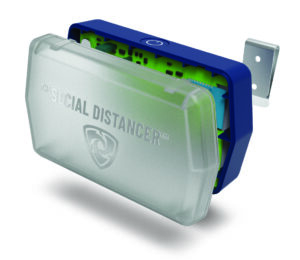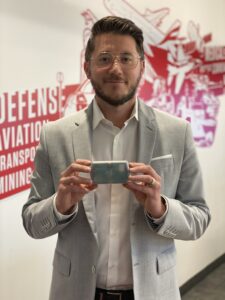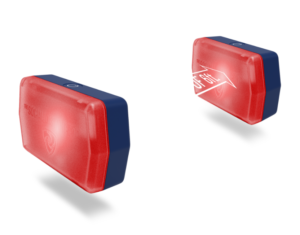
Promark collaborates to create social distancing device during pandemic
Stephen Law
Automation / Robotics Electronics Wireless Engineering Wearable Technology Covid 19 Covid 19 distancing distancing social social wearable wearableThe Social Distancer wearable device is designed to provide workers with a means to easily maintain a safe two-meter distance between one another

The Social Distancer, a wearable product designed to provide workers with a means to easily maintain a safe two-meter distance between one another. Source: Social Distancing Technologies Inc.
As workers in manufacturing environments continued to execute their jobs amid COVID-19, actual conditions made it very difficult for them to follow recommended physical distancing standards. These very circumstances held true for two such manufacturers in Quebec – Promark Electronics Inc. and CMP Advanced Mechanical Solutions.
Struggling to assure staff that their work space was safe, Promark president Jarred Knecht collaborated with John Soares and Steve Zimmermann at CMP to design a device that would ensure employees keep a safe distance under social distancing protocols during the pandemic.
“As an essential service provider, we were seeing early on in the lockdown that it was increasingly difficult to convince people it was safe to come to work,” says Knecht, adding that Promark took extreme measures to ensure safety, such as bringing a nurse on staff and equipping everyone with PPE gear.
“But, we also discovered that some people have difficulty respecting others personal space. Some people have difficulty understanding and calculating what two meters distance really is– all the time during the day,” Knecht adds. “We proceeded with this project for our own two companies – to help protect our staff. And, through the design process we realized that a lot of other companies have similar challenges,” he adds.

Jarred Knecht, president of Promark Electronics and co-founder of Social Distancing Technologies Inc.
Three manufacturing veterans
It wasn’t long before conversations had these three manufacturing veterans unite their companies’ expertise and co-founded Social Distancer Technologies Inc., to create, the Social Distancer, a wearable product designed to provide workers with a means to easily maintain a safe two-meter distance between one another.
Formed in 1987, Promark is described as a combined system integrator / contract manufacturer, with customers all over North America. For years, Promark has had a collaborative relationship with CMP, a Chateauguay-based CEM with expertise in electro-mechanical design and manufacturing. Early conversations in the process revolved around how to harness the best, most relevant resources out of both firms to create something of their own – leveraging a pool of almost 1,000 employees between both firms.

Devices are designed to beep, vibrate and/or light up once the two metre distance between wearers is breached. Source: Social Distancing Technologies Inc.
“Through the years we have been in business, we have been responsible for bringing thousands of products to market for others,” says Knecht. “So, it was determined that we would use our collective expertise to do what we know best – and that is to build things – and, build them fast.”
Put on ‘start-up’ hats
The trio quickly put on their ‘start-up’ hats on. However, unlike a true startup, the team had 30+ years of experience and resources to pull from. As a result, the entire process was expedited, avoiding a lot of the gaps a true start-up may experience. The team’s background and knowledge allowed them to go from a conversation to a company, to a product, to a patent, to a trademark, to going online and selling that product to customers – all within a four-week period.
The credit-card size, one-inch thick patent-pending device calculates the distance between employees. It has three methods of alert — visual, vibration and tone — to instantly notify employees. If employees are within 2.5 meters of one another, the device will flash red, vibrate and audibly alert the employees to move farther away. These alerts are all customizable as well. Priced at CND$199 per unit, or $1,990 per pack of 10 units, the Social Distancer lasts 10-12 hours on a single charge, which is the duration of one full shift.
“That is the thing with being a contract manufacturer, as we are constantly pivoting based on the OEMs changing needs and products. Fortunately, we are used to this. We are very adaptable by the nature of our business,” Knecht who also carries the title of co-founder and COO of the newly formed concern.

The distancing devices require no infrastructure and can work inside or outside without any need for a gateway or antennas.
No infrastructure required
Ease of implementation to the system is also key to its success, according to Knecht, as he points out that there is no infrastructure required to have it operate. The self-sufficient devices can work inside or outside without any need for a gateway or antennas.
“Employees can go on with their workday without the need for any awkward conversations, unexpected proximity issues, or discrepancy about what exactly six feet is,” said John Soares, co-founder and VP of Social Distancer Tech and EVP of CMP Advanced.
Knecht conducted live demos with customers over video conferencing platforms, showing how the devices are used. First envisioned for use within his own operations, Knecht says the social distancing product is an obvious necessity within manufacturing environments, especially in critical sectors such as food processing facilities – even distribution centres.
“Through our conversations with customers, they are educating us as well. We thought we had considered every use case – until having customers point out several others. It has been great,” Knecht says.
Once again, drawing from its established contacts given previous dealings at the National Research Council (NRC) of Canada, Knecht and his newly formed concern were able to access support via the Industrial Research Assistance Program (NRC IRAP). The response was immediate, due to the device being a technology product created by Canadians and COVID-19 related.
“So, within a couple of days the conversation went from discussing the idea and us filling out the applications to receiving approval. It was very, very fast.” Knecht says the NRC’s support was helpful with its guidance in the launch of the device, even assisting during the post research and development phase.
Hardware, software design
Promark’s contributions to the device’s creation involved electronic hardware, software design and product safety testing, while also managing the early prototyping all the way to full production runs.
Having to operate within a pandemic environment forced communications to a virtual format and it actually facilitated a speedier turnaround, according to Knecht. Using conference platforms, such as Zoom and Skype, permitted quick assembly of virtual conferences or strategy sessions online. Everyone was easily and always accessible to meet.
“These tools allowed us to keep a cadence between the different people involved, who each had different responsibilities. This situation (pandemic) created the need for the product, but it also facilitated our ability to get it done fast.”
Another advantage to users, is that the device does not come with any privacy concerns, eliminating employees concerns that it may also serve as a tracking device by management.
“We did have one employee bemoan that our product would detect the frequency of her trips to the bathroom or coffee area.” Not so, says Knecht. “Our goal was to give the people the tools necessary to be responsible with social distancing, but not make it feel like ‘Big Brother’ or that you’re policing them,” he adds.
Delivery of the product to end-users was scheduled for early this June. In a post-pandemic world, Knecht says his device may serve multiple purposes. The other potential end-users are eclectic, led by pharmaceutical companies; medical device makers; event (indoor and outdoor) organizers, theme parks – to grocery, retail and some restaurant type operators.
“Our objective from the start has been to try and get this product to market as fast as possible, because we know from past experience that our own customers will tell us what the possibilities are. A lot of companies often get stuck in this infinite loop of R&D. They will iterate and iterate themselves to death.
